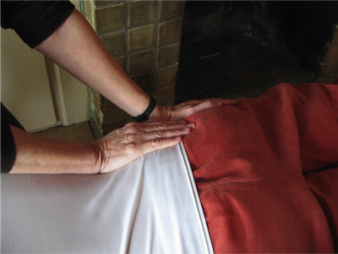5212 Claremont Avenue
Oakland, CA 94618• Mon. • Wed. • Fri. • 10am-6:30pm (by appt.) •
• Tues. 12pm-8pm & Thurs. 9am-4pm (by appt.) •Gynecological + Pregnancy
A large number of women suffer from unnecessary gynecological problems.
I make this bold statement based on discoveries I have made in dissecting more than 250 cadavers. Sixty percent of the female cadavers had adhesions of the uterus, ovary, and fallopian tube to one of the psoas muscles. The gynecological structures appeared shifted to one side with fibroids seen on the shifted side of the uterus. If the uterus presented over the right side then the fibroids would be on the right and back of the right side.
The psoas muscle starts on the side of the lumbar spine, connects to the ilium and sacrum, and goes down through the pelvis, attaching to the inside of the leg. The psoas muscle, therefore, spans the pelvic girdle while functioning as one of the main muscles in lifting the leg and walking. The human nervous system regards the pelvic girdle as a vital cavity. ANY distress signals from the joints of this vital cavity will initiate a guarding response. Most of the complaints will be manifestations of the woman’s body trying maintain its integrity – that is, an effort to keep the alignment from getting worse. The body’s main defense mechanism is to tighten the involved muscle groups, which, after a length of time becomes painful. (Clinch your fist and hold it that way. How long before it starts hurting? OK, you can stop.)
The asymmetry of the organs and their adhesion to the side of the pelvis, I believe is caused by the displacement of the ilium relative to the sacrum or a subluxation of the sacroiliac joints and pubic symphysis. Because of the body’s guarding mechanism, this displacement causes a rigid response of the psoas, and other back, hip and thigh muscles. In turn, the rigidity of the muscles results in pain and limitations in movement and walking. (This is the body’s acceptable alternative to having the bones disassociate with the possibility of death.)
A displacement pattern of one hipbone going superior, high or towards the shoulders, causes a shift of the gynecological organs to that side.
If this gynecological shift continues for years, it results in the tissues adhering to one another. This pattern of distortion or overstretching initiates chronic inflammation and causes the uterus and ovaries to change their shape as well as their position. Fibroids or fibroid tumors are actually changes to the muscle tissue of the uterine wall. An animal study showed that muscles that were stretched and twisted for a three-month period of time, tended to become fibrotic. In addition to the tissues and organs changing shape, the nerves and circulatory system can become involved. The nerves, arteries and veins come from the back of the pelvis forward to the organs. A shift of the organs will mean a stretching and, possibly, twisting of these neurovascular bundles. Chronically this will result in diminished nerve supply, (stretching of animal nerves reduces conductivity), blood supply, (arteries narrow with stretching) and congestion (veins will collapse with physical stress.)
Inflammation and adhesions in the pelvic girdle are attributed to surgeries, ischemic tissue (lack of blood), and idiopathic (unknown) causes. My review of the literature indicates that pelvic bone misalignment is not part of any assessment of women who have pelvic adhesions.
Orthopedists and gynecologists are taught that the pelvic bones do not move out of place. Sometimes this is called “the rigid pelvic theory.” However my first hand experience shows that the pelvis can suffer “deforming” misalignment. How is rational care available to women if this possible diagnosis is overlooked?
A number of female patients relate a history of trauma — motor vehicle accidents or horse back riding falls — in their youth, the development of gynecological problems a few years later, and a resulting hysterectomy in their 40’s. Car accidents are the major cause of pelvic displacements. During an accident, having one’s foot on the brake at the moment of impact can result in the right side sustaining more of the impact with the right hipbone being knocked superior on that side.
Time for a story…
A number of years ago my wife, who was a cervical cancer survivor, was in a motor vehicle accident. A few weeks later she was scheduled for her semi-annual cancer check up. I went with her for this examination because I wanted to do an experiment. Diane had suffered a pelvic girdle injury in the accident and was suffering pain and other complaints that were a new phenomenon for her. Diane’s doctor was familiar with me and knew I am a chiropractor.
I showed her how Diane’s pubic bones were not lined up: the right side was higher than the left and the right side of the abdominal wall tight and painful. The doctor started the examination by entering the pelvis through the vagina and this was so painful Diane almost levitated off the table. Both noted she had never been that sensitive before. The doctor said, “It’s really tight in here, the uterus is over to the right side. I can’t get to the right ovary; I can easily get to the left ovary. This feels completely asymmetrical.” She completed the Pap smear.
Then I adjusted Diane. I showed the doctor the change in pubic bone alignment and how the abdominal wall was soft on both sides with the tenderness gone. She then re-gloved and re-entered Diane’s pelvis, noting the lack of pain response. The doctor said, “This feels completely different, I can easily get to the right ovary, the uterus feels like it is in the middle. Could this be the source of all this pelvic pain I encounter in so many of my patients?”
Let us suppose this pattern of bone displacement persists when pregnancy occurs, it is very likely that problems will develop during the pregnancy.
The fetus will shift to the superior or high side and descend onto the psoas on that side, making it difficult to lift that leg or walk. A common remediation would be to put the expectant mother to bed for the duration of the term. During delivery, a subluxated pelvic bone can result in the baby’s head ending up egg-shaped instead of round.
Another major cause of pelvic problems, I suspect, is the use of the automobile in pregnancy, especially during the third trimester. The third trimester is characterized by a release of the hormone relaxin, which loosens the ligaments body-wide but most significantly in the pelvis in anticipation of labor and delivery. The awkward, asymmetrical, repetitive body mechanics of getting into and out of the vehicle could be a unrecognized stressful factor. The pregnant women in the later months of her term might end up with a pelvis that is out of alignment. This could contribute to painful, difficult weeks before labor and prolong delivery.
Fast-forward to the second pregnancy: the woman is continuing to use her car, now with the addition of a small child and all the other demands of motherhood, with that relaxin-influenced pelvis. The result is an inability to recover a normal pelvic alignment post-pregnancy. Because of the body’s guarding mechanism, this subluxation produces chronic low back pain. A common scenario is a middle-aged woman coming into my office saying she has had low back pain for as long as she remembers. My first question is how old are the children. Children 20 or older would constitute a time frame properly described as “for as long as I can remember,” because I think our memory pre-childbearing is pretty much wiped out.
We have noted how a subluxation in the pelvic joints can cause pain, difficulties moving, in pregnancy and possibly fibroids. There are three additional areas that are affected by pelvic joint displacement: bladder control, menstruation and sex.
URINARY PROBLEMS
The bladder rests against the back of the pubic bones. Any posterior displacement of a pubic bone compresses the bladder against the uterus and reduces its volume, making it necessary to void frequently. If the uterus is enlarged the result is constant pressure on the bladder and there will be no relief after urinating. Further, pressure on the bladder by one pubic bone makes the bladder wall hyper-sensitive making the voiding signal evoked more easily.
The most extreme case of pubic misalignment creating bladder problems occurred in a twenty-six year old woman who had to go the bathroom every 15 to 20 minutes. She had to wear diapers on public transportation and her life choices were severely limited. On physical examination the left pubic bone was so posterior that I could feel the entire inside of her right pubic bone. The bladder had no room to expand thus creating a constant sense of urgency. She had been suffering with this condition for twenty-two years, following a vehicle accident as a pedestrian at age four. Two weeks of chiropractic care resulted in her being able to void every 2 to 3 hours.
MENSTRUATION
The distress pattern described above with the shifting of the nerves, arteries and veins can make the menstruation cycle uncomfortable to debilitating. When an artery is stretched it gets narrower and cannot respond properly to hormonal commands to deliver more blood. The inability of the arteries to supply the uterus monthly increased demand for blood by the uterus without the demand being met will result in cramping and pain. This condition is called ischemia, in heart muscle this condition is called a heart attack. (If the ischemic uterine muscle “infarcts” or dies could this be the origins of the fibroids?)
When veins are stretched and/or twisted they cannot fully drain the uterus, leaving the uterus partially engorged and preventing a full recovery cycle. When nerves are stretched the conductive impulses are diminished. All of this can result in terrible monthly experiences, which can only be temporarily and incompletely masked by drugs.
SEX
The pelvic floor is soft tissue. If it is stretched out of its normal shape or if it becomes rigid as a result of a defensive guarding mechanism, sex can become painful. In the story above about Diane, the penetration of the distressed pelvic tissue caused significant pain. When the pubic symphysis was aligned moments later, the same penetration was not painful.
Realigning the pelvic bones can be an important event for a woman: I have seen extensive problems relieved through chiropractic adjustments.
What I am saying is controversial within my own chiropractic community. Simply stated: There are three bones and three joints in the pelvic girdle. The bones are not stationary and can in fact be misaligned in relation to each other. This displacement can be missed in x-rays and needs to be manually evaluated. Pharmacological interventions can mask the discomfort but not remedy it. Establishing aligned, non-tender, stable pubic symphysis and sacroiliac joints can have enormous, sometimes life-altering, benefits for women.

